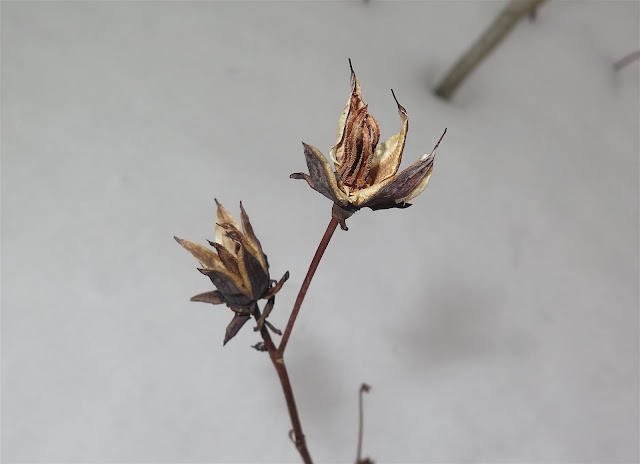 Thursday, February 4: Here it was at last: that perfect winter day! A cobalt sky, clear of the merest trace of filtering clouds. A bright February sun, now reclaiming some height in that sky and adding some warmth to its rays. Fresh clean snow, still kickably powdery in the woods as the temps rose warm enough to breathe but not so warm as to melt that powder to mush. And lucky for me, I knew of a marvelous place to make the most of this perfect winter day: the snow-covered trails leading down to the solidly frozen surface of Lake Bonita. So off I went to this small unspoiled lake near the summit of Mount McGregor in Moreau Lake State Park.
Thursday, February 4: Here it was at last: that perfect winter day! A cobalt sky, clear of the merest trace of filtering clouds. A bright February sun, now reclaiming some height in that sky and adding some warmth to its rays. Fresh clean snow, still kickably powdery in the woods as the temps rose warm enough to breathe but not so warm as to melt that powder to mush. And lucky for me, I knew of a marvelous place to make the most of this perfect winter day: the snow-covered trails leading down to the solidly frozen surface of Lake Bonita. So off I went to this small unspoiled lake near the summit of Mount McGregor in Moreau Lake State Park.

A remarkable feature of Lake Bonita is the presence of many small shrub- and sphagnum-covered islands that dot the lake. Since paddling this lake is forbidden (in order to protect its pristine, invasive-free waters), the only time I can explore these little islands and their fascinating botanical inhabitants is when the surface is frozen good and solid. A previous week of close-to-zero nights had produced good solid ice, before the recent snowfall covered the ice with about four inches of fluffy stuff, dazzling today beneath that radiant sky.
While the remnants of most of the low-growing acid-loving plants -- the sundews, the sphagnum mosses, the bladderworts, the small pink orchids -- are now well-buried, the shrubby growths, still retaining their desiccated leaves and seedpods, cast intriguing shadows across the snowy expanse.
The most dominant of these shrubs is Leatherleaf (Chamaedaphne calyculata), which retains its leathery leaves throughout the winter. Normally green, the leaf-tops now take on a rosy cast, and the twigs are already studded with the buds that will open into small white bell-shaped flowers in early spring.
Some of the Leatherleaf twigs still retain the remnants of last-fall's seed pods. Having split open to spill the seeds, the husks of the pods now look like small tan-and-burgundy flowers in their own right.
The second most prolific shrub on the islands is Sweet Gale (Myrica gale), which does not retain its leaves through the winter, but it certainly has readied itself for spring by producing many cone-shaped glossy buds.
Here's a closer look at Sweet Gale's glossy mahogany-colored buds, each pointed scale outlined in white.
I always search among the Sweet Gale shrubs for the female ones containing the seed pods, dried now and ready to open and spill the seeds on the snow. Although brittle and seemingly desiccated, the pods are actually sticky with a fragrant resin that perfumes my fingertips when I pinch the pods, the fragrance persisting until I next wash my hands. The "sweet" part of this shrub's vernacular name is well deserved!
Sheep Laurel (Kalmia angustifolia) is the third most populous shrub on these islands, and its ruddy leaves are much in evidence now, as are the clusters of seedpods where this acid-loving shrub bore clusters of vividly pink flowers in June.
I know that Water Willow (Decodon verticillatus) grows out here, for I've spied through binoculars from shore a few of its flexible stems bearing purply-pink axillary flowers edging some of the islands in late summer. But the population always seemed so sparse, I felt quite surprised to find its remnants emerging from the snow.
Another (but less happy) surprise was that I did NOT this year find the chubby flower heads of Northern Pitcher Plants (Sarracenia purpurea) standing tall on long stalks well above the snow cover. I know that they grow abundantly out here, as this photo from several years ago attests. But I could find not a single one this year, where in other winters I've found dozens. I hope this species is not disappearing from these sphagnum-covered islands, the very kind of acidic habitat that it normally prefers.
After staring so long at plant remnants etched against the dazzling snow, my eyes grew weary of the glare. The tree-lined south bank of the lake was casting long shadows across the lake, and I gladly headed toward this shore and its shady relief for my eyes.
The tracks of many wild animals criss-cross the lake, and most were too obscured by blown snow to allow for accurate identification. But deer tracks are usually easy to ID, since their heavy weight and two-toed hooves leave very distinctive prints. As I walked in the shade near shore, I was curious about this set of tracks, which indicated at least one deer kept approaching the leaning boughs of this Red Maple (Acer rubrum). A closer inspection of the boughs revealed that many of the plump reddish buds of the maple were missing. Looks like deer enjoy nibbling on Red Maple buds!
Whoa! Speaking of RED! These vividly hued Highbush Blueberry branches (Vaccinium corymbosum) certainly announced their presence, especially arrayed against the dark-green background of Eastern Hemlocks (Tsuga canadensis) that form a near-monoculture of trees on the north-facing rocky shore of Lake Bonita.





















































